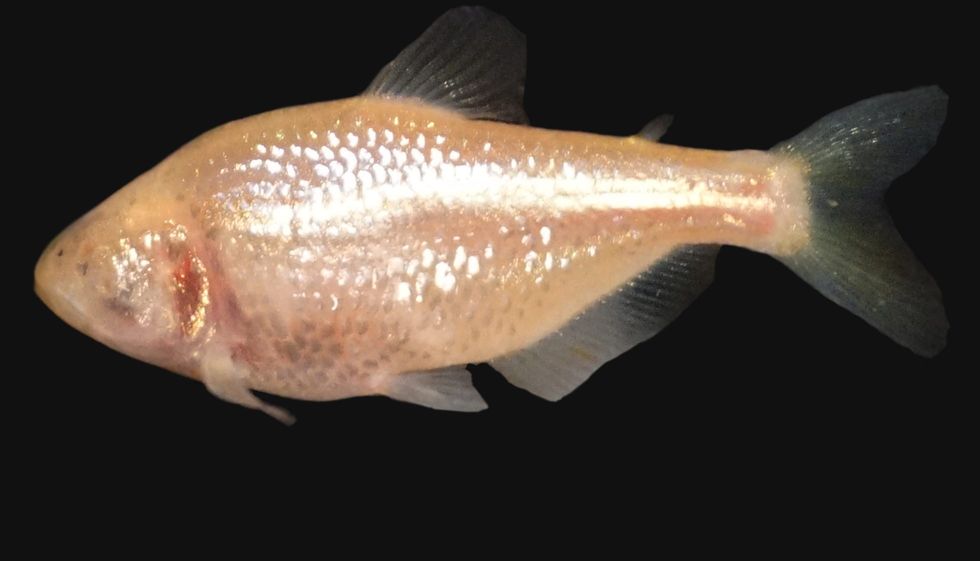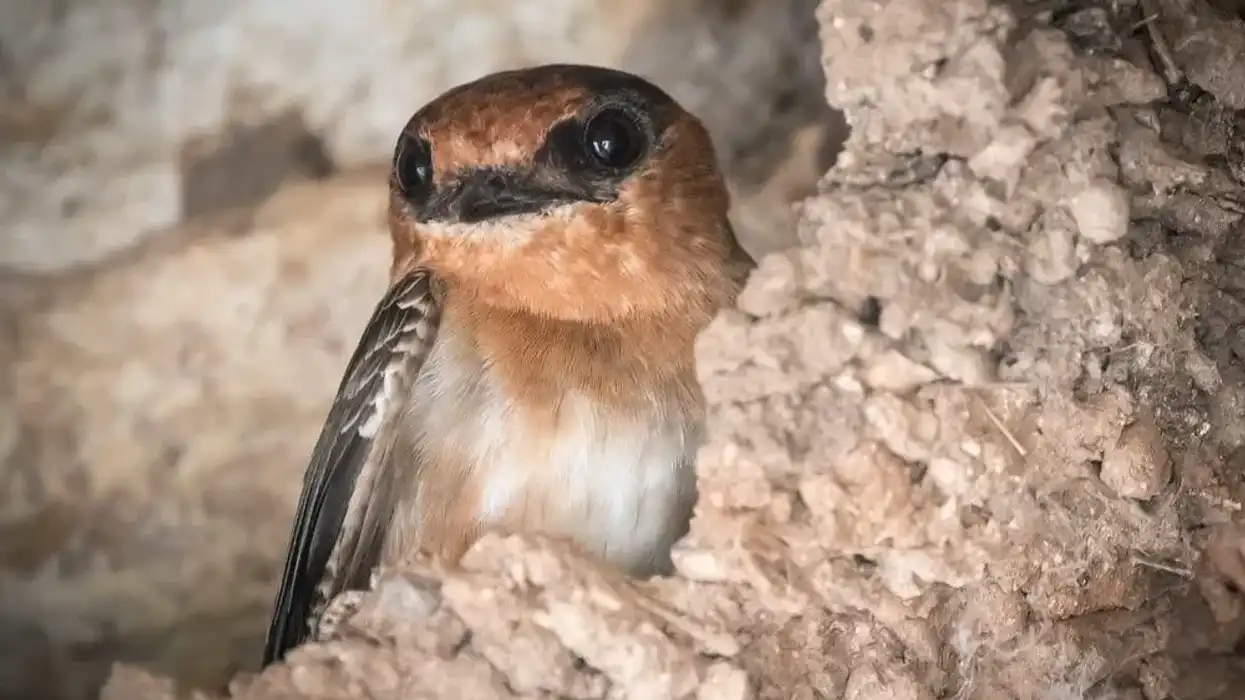The Mexican tetra or Astyanax mexicanus, also known as the blind cavefish, is a type of cave-dwelling freshwater fish found in the rivers of the Rio Grande, Texas, and Mexico. Living in deep and dark conditions, cavefish have undergone extreme evolution.
Over the years, they have lost their eyes. They do not possess any circadian rhythm.
While growing, a gene mutation prevents the passage of blood to their eye region which results in them never developing eyes. Moreover, this evolution has led them to have asymmetric cranial bones which give them a distinct bend in their dorsal region.
Some cavefish species like those in the Micos cave can still sense light with sensory cells located in their pineal gland. These fish species navigate the dark waters on the basis of their lateral line that can distinguish vibrations and differences in pressure.
The Mexican tetra is currently known to inhabit 30 different caves across the world. There are different forms among the cavefish Astyanax and all these species can interbreed. These blind cave-dwelling creatures have been subject to various evolution-based surveys to study their genetic composition as they are a great example of convergent and parallel evolution.
To know more about such fishes, check out spiny dogfish facts and herring facts.
Cavefish Interesting Facts
What type of animal is a cavefish?
Astyanax mexicanus is a type of freshwater fish that lives in caves and have lost their eyes.
What class of animal does a cavefish belong to?
The blind cavefish belong to the class of Actinopterygii or ray-finned fishes like puffers and parrotfish.
How many cavefish are there in the world?
It is known that there are currently populations of more than 1 million blind cavefish in the world but the exact number is not known. The populations have been relatively stable over the past decade and they do not face any immediate threat.
Where does a cavefish live?
The blind cavefish occurs in the Nueces and Pecos Rivers in Texas, and parts of central and eastern Mexico. They are also believed to be present in Belize and Guatemala, though this has not yet been confirmed.
What is a cavefish's habitat?
The blind cavefish are found to live in subterranean caves occurring in inland freshwater or wetland regions. They are found along the sandy or rocky bottomed pools and backwaters.
Who do cavefish live with?
The Mexican tetra cavefish live in groups of three or more. They are usually a part of larger packs and even when kept in captivity, it is preferable to keep them in groups.
How long does a cavefish live?
The average lifespan of the underground living Mexican tetra is around 10 years in the wild.
How do they reproduce?
There is some diversity in the species. The diversity includes both cave-dwelling and surface-dwelling varieties to the Mexican tetra.
Both these related types, belonging to the Genus Astyanax can engage in reproduction leading to fertile offspring. When observed in a lab, it was seen that these fishes do not have a specific spawning period or breeding season.
Rather, females lay thousands of eggs every week at any time of the year. However, in some other species, specific spawning periods were found (though these extended over six months).
The reproduction patterns of the species are under debate. Generally, fertilization occurs when a male and a female swim parallelly resulting in the release of the sperm and eggs.
Overall, these fishes are extensive breeders and females only showed a preference for fish larger in size. A single female can mate with multiple partners.
After laying eggs, no gender showed parental tendencies. In fact, to boost their evolutionary chances, both parents engaged in cannibalism and ate their eggs.
The killing of offspring strengthens the ecosystem by leading to better reproduction changes and survival for the elders. It is also known that these fishes are compulsive eaters and store a lot of reserve fat since their habitats and dark environment are not always forthcoming with food.
What is their conservation status?
Based on their populations and threats, the International Union for Conservation of Nature (IUCN) has classified them as an animal of Least Concern. Due to this, there are no ongoing conservation efforts regarding them, nor do they naturally occur in any protected waterbody.
They are not commercial species and are not subject to fishing or breeding in fisheries. The fish populations were earlier also found in New Mexico where it is now rare due to water pollution, siltation, and channelization.
Groundwater pollution harms cavefish due to seepage via aquifers. Apart from this, the blind cavefish does not face any specific threats.
Cavefish Fun Facts
What do cavefish look like?

Covered by white to pink scales, the blind cavefish is only around 4.7 in (12 cm) long with two dorsal fins. Between the dorsal and caudal fins, there lies an adipose fin. They have a small mouth located in front along with a wide, streamlined shape. This is also known as a typical characin shape.
Their bodies are covered with scales. Their most prominent feature is the complete lack of eyes. Usually, their eye sockets also lie under scales, appearing as two dark spots.
How cute are they?
Overall, the lack of eyes makes the blind cavefish a vulnerable-looking creature. However, they are known to get semi-aggressive as they grow older. Their small size and pale color make them look like a nice, cute addition to any aquarium.
How do they communicate?
Due to their lack of eyes and life spent in the dark, the blind cavefish has emerged with an evolutionary lateral line system. This channel running inside the skin along the top is sensitive enough to detect vibrations and pressure changes.
The Astyanax fasciatus mexicanus effectively use this to communicate via signals and find prey. Their heightened sense helps them to hunt for food ad also avoid obstacles.
How big is a cavefish?
Blind cavefish are very small and all mutations are known to grow only as big as 4.7 in (12 cm). They are the same size as mollies or one-third the size of a large goldfish.
How fast can a cavefish swim?
Cavefish are known to have a speed of around 0.2 mph (0.3 kph). This is not very fast for a fish however considering that their habitats and environment do not offer larger predators for them to be wary about, they survive just fine.
How much does a cavefish weigh?
Not much research has been done on the weight of the cavefish.
What are the male and female names of the species?
Both males and females of the fish species are known as blind cavefish or Mexican tetra.
What would you call a baby cavefish?
A baby cavefish is known as a fry when it emerges from the egg.
What do they eat?
Cavefish mainly eat other animals including worms, larvae, crustaceans, insects, and other smaller fish. They are omnivorous as they might also feed on algae and plant matter. Sometimes, they also eat their own young ones.
Are they poisonous?
No, the Mexican cavefish is not a poisonous species.
Would they make a good pet?
The Mexican tetra cavefish species makes for a good pet, despite being evolutionary-wise accustomed to living in dark, dingy caves. Being exposed to light has no effect as their lack of eyes makes them disregard it altogether.
Even if they are exposed to light while growing, cavefish do not develop eyes. Overall, they are docile and easy-going animals who are prone to eating a lot and deriving fat stores from their diet.
Based on their ecosystem, they prefer slightly alkaline water. If kept in an aquarium, one can give them fish diet pellets which they will forage from the bottom of the tank.
Did you know...
The Mexican cavefish species that occur in caves did not naturally occur there. Rather, cavefish overtook caves around 25,000 years ago and underwent rapid evolution and genetic changes to survive in the new habitat.
The loss of eyes from their biology was not simply a matter of the fish living in the dark. Rather, it had many other advantages as well. Such as the abandonment of the circadian clock.
The lack of eyes meant one less organ to protect from infections. However, some scientists see the lack of an eye as an example of devolution instead of evolution.
The body of the blind cavefish species is cream or pinkish in color due to the lack of any pigment. The pigment was seen as a useless adaptation for their life in the dark habitat where little sunlight reached. Hence, it was evolutionarily removed from cavefish biology.
Due to the lack of eyes, these animals have asymmetric skulls. This means that their skull is slightly bent to the left, along with one of their dorsal fins.
This could be because these animals are habituated in life to moving in a counter-clockwise direction within their caves. As fish living in a dark and isolated habitat, these animals do not have any natural predators.
The minnows have excellent eyesight and are found in open habitats. The cavefish, on the other hand, dwell in dark caves and do not have functioning eyes.
However, there is some history in common between them, The placement of their internal organs along with their muscles and bone structure have led scientists to believe that they share some ancestry with minnows.
How many species of blind cavefish are known?
Generally, cavefish as a term can refer to over 200 different species of blind fishes that dwell in a subterranean cave habitat - both in freshwater and brackish water. This includes families like Characidae, Balitoridae, Cobitidae, Cyprinidae, Nemacheilidae, and more.
All of these species are small in size and some are even threatened species. A few species of cavefish exist in underwater cave habitats with karst topography. There is little data available regarding these cave-dwelling creatures due to very few proper surveys being conducted in such deep and dark places.
It is believed there are many unidentified species of blind cavefish waiting to be discovered. Some other species include the armored cavefish and the albino cavefish as well.
Are cavefish edible?
These fish are not eaten by humans nor bred for commercial purposes.
Here at Kidadl, we have carefully created lots of interesting family-friendly animal facts for everyone to discover! Learn more about some other fishes from our sawfish facts and sprat facts pages.
You can even occupy yourself at home by coloring in one of our free printable cavefish coloring pages.










